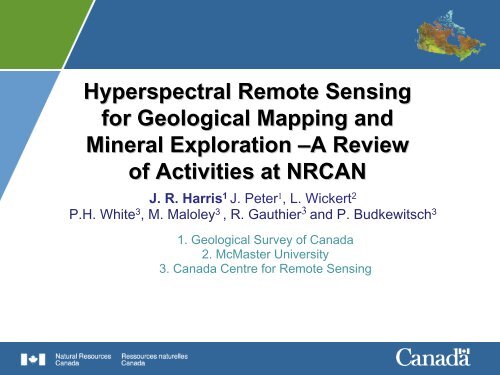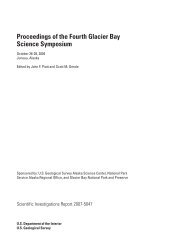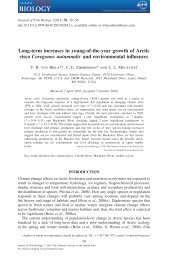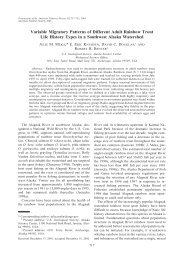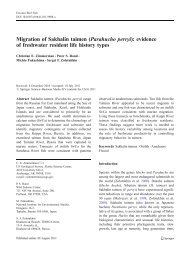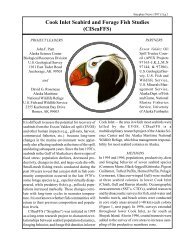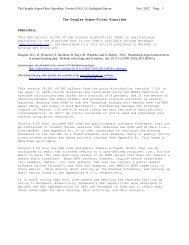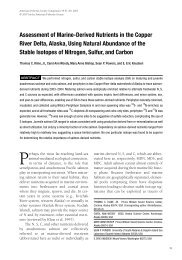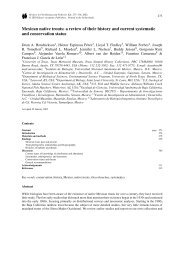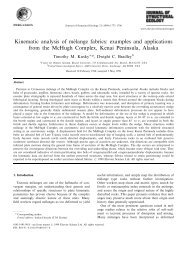A review of hyperspectral remote sensing research for geological ...
A review of hyperspectral remote sensing research for geological ...
A review of hyperspectral remote sensing research for geological ...
You also want an ePaper? Increase the reach of your titles
YUMPU automatically turns print PDFs into web optimized ePapers that Google loves.
Hyperspectral Remote Sensing<br />
<strong>for</strong> Geological Mapping and<br />
Mineral Exploration –A A Review<br />
<strong>of</strong> Activities at NRCAN<br />
J. R. Harris 1 J. Peter 1 , L. Wickert 2<br />
P.H. White 3 , M. Maloley 3 , R. Gauthier 3 and P. Budkewitsch 3<br />
1. 1. Geological Survey <strong>of</strong> Canada<br />
2. 2. McMaster University<br />
3. 3. Canada Centre <strong>for</strong> Remote Sensing
Background papers….<br />
• Harris et al. 2005, CJES, V. 42, pp.2173-2193<br />
• Rogge et al. 2007, RSE, Vol 10, Issue 3, pp. 287-303<br />
• Harris et al. 2006, CJRS Vol. 32, no. 5, pp 341-354<br />
• Rogge et al. 2009, Reviews in Economic Geology: Remote Sensing<br />
and Spectral Geology, eds., Bedell, R., Crosta, A.P. and Grunsky E.,<br />
V. 16, Society <strong>of</strong> Economic Geologists, pp 209-222<br />
• Harris et al. 2010, CJRS, Vol. 36, No. 4
The Hyperspectral World<br />
• The acquisition <strong>of</strong> images in hundreds <strong>of</strong> registered, contiguous<br />
spectral bands such that <strong>for</strong> each picture element (pixel) <strong>of</strong> an<br />
image it is possible to derive a complete reflectance spectrum”<br />
(Goetz et al., 1985)<br />
• Many bands – narrow band width – 10 – 15 nanometers – high<br />
spectral resolution – moving from the world <strong>of</strong> discrimination<br />
to identification!<br />
• Generally high spatial resolution (at least on airborne plat<strong>for</strong>ms)<br />
• All systems are airborne except <strong>for</strong> one –Hyperion but many are<br />
coming!<br />
• More complicated processing!<br />
• DN-radiance<br />
• Atmospheric
Hyperspectral Imaging<br />
• Layers or bands are select slices <strong>of</strong> the light spectrum, each <strong>of</strong> which contains<br />
different in<strong>for</strong>mation about surface composition<br />
• Each pixel stack is a spectra that provides in<strong>for</strong>mation about the surface<br />
composition“fingerprint”
Multispectral Versus Hyperspectral<br />
Spectral Resolution!
Unique Spectra<br />
• Controls on absorption <br />
• electronic transitions and charge transfer processes<br />
(changes in energy states <strong>of</strong> electrons bound to to atoms or<br />
molecules) associated with transition elements - Fe, Cr, Ti etc.<br />
- determine the position <strong>of</strong> diagnostic absorption bands in the<br />
VNIR<br />
• Vibrational processes (small displacements <strong>of</strong> atoms around<br />
their resting positions) in H 2 O and OH - and CO 3 results in<br />
fundamental overtone absorptions in the SWIR<br />
• Higher energy levels required required <strong>for</strong> electronic<br />
processes, there<strong>for</strong>e occur at shorter wavelengths result in<br />
broad absorption features (i.e. Fe) – SWIR – sharper and<br />
deeper absorption features (less energy required)<br />
• Manifestations <strong>of</strong> these effects:
What are the characteristics <strong>of</strong> a spectra that we look <strong>for</strong>
….Spectral Variability will result in the shift in<br />
position and shape <strong>of</strong> absorption bands as<br />
well as suppress spectra<br />
• Chemical variability (calcite dolomite and solid solution series)<br />
• Grain size (smaller grain size = higher reflectance)<br />
• Illumination conditions / topography – very import <strong>for</strong> Northern<br />
environments<br />
• Atmosphere (lab measurements vs. in situ or airborne<br />
measurements)<br />
• Weathering – <strong>hyperspectral</strong> sensors only see what is on the surface<br />
– no penetration!
Alteration Minerals Identifiable by<br />
Short Wave Infrared Spectrometry<br />
• Clays: Kaolinite, Dickite, Halloysite, Pyrophyllite, Illite-Smectite,<br />
Montmorillionite<br />
• Micas: White mica (Sericite), Illite, Phengite, Muscovite, Paragonite,<br />
Biotite, Phlogopite, Pyrophyllite, etc.<br />
• Chlorites: Variations in Fe, Mg content<br />
• Other Phyllosilicates: Serpentines (Lizardite, Antigorite), Fuchsite,<br />
Talc, Nontronite<br />
• Amphiboles: Tremolite, Hornblende, Actinolite, Anthophyllite<br />
• Carbonates: Calcite, Dolomite, Ankerite, Siderite<br />
• Sulphates: Alunite, Jarosite, Gypsum<br />
• Tourmaline: Fe-tourmaline, Tourmaline<br />
• Major Absorptions:<br />
• Al-OH: clays, micas<br />
• Fe-OH: chlorites, serpentines<br />
• Mg-OH: serpentines, chlorites, micas, epidote, some amphiboles
BUT !……rocks are composed <strong>of</strong> a combination<br />
<strong>of</strong> minerals, there<strong>for</strong>e it cannot be expected that<br />
the spectral features <strong>of</strong> rocks will be as well<br />
defined as the spectral features <strong>of</strong> individual<br />
minerals – the difference in application between<br />
<strong>geological</strong> mapping and mineral exploration<br />
(detecting suites <strong>of</strong> alteration minerals)
What about the Canadian Environment<br />
Northern vs. southern environments<br />
Vegetation (south) and lichen (north)!!!!
Geological Mapping (bedrock)
Example # 1 – Southeast Baffin Island<br />
St-Onge<br />
et al<br />
Source – J.R. Harris et al – CJES
MNF Ternary<br />
Image<br />
Wow!…..great<br />
colours<br />
but do they represent<br />
lithology
….…results <strong>of</strong> field work<br />
Rock Type<br />
MNF<br />
colour<br />
Weathering<br />
colour<br />
Primary<br />
minerals<br />
Secondary<br />
minerals<br />
Orthoquartzite<br />
Metasedimen<br />
ts<br />
Red white Qtz<br />
Green – yellow orange Plag–8-15%,<br />
Kfeld – 15-30%<br />
Qtz – 30-60<br />
Gt – 8 –10%<br />
Metagabbro Blue (veg!) dark<br />
Metatonalites Cyan grey Plag–25-30%<br />
Kfeld – 15-30%<br />
Qtz – 30-35<br />
Gt – 5 –10%<br />
Monzogranit<br />
es<br />
Magenta grey Plag–20%<br />
Kfeld – 40-50%<br />
Qtz – 40-50<br />
Gt –3 %
Metagabbro / diorite –<br />
response to vegetation!
A- Fe ratio (23/1)<br />
A<br />
Iron ratio image<br />
…the importance <strong>of</strong> iron!<br />
Clay ratio image<br />
B. Clay ratio (110/77)
…making a spectral map<br />
A spectral map can be<br />
created by photogeologic<br />
interpretation <strong>of</strong> the MNF<br />
image…this is a simple but<br />
effective (this is how<br />
geologists traditionally<br />
create a geology map from<br />
air photos!)<br />
1 km
Mineral Exploration
SINED Hyperspectral Project<br />
Project Objective<br />
<br />
To map the <strong>hyperspectral</strong> response <strong>of</strong> areas known to host volcanogenic massive<br />
sulfide (VMS), Fe-hosted gold and orogenic gold mineralization in Canada's North<br />
using airborne <strong>hyperspectral</strong> sensors.<br />
Project Aim<br />
To evaluate the effectiveness <strong>of</strong> the technology and provide the data:<br />
To develop methodologies using <strong>hyperspectral</strong> sensors that can be used to vector<br />
toward concealed mineral deposits in Canada’s north (north <strong>of</strong> 60°) which can be<br />
mined, and which will provide employment and revenue <strong>for</strong> the peoples <strong>of</strong> Canada’s<br />
North; and<br />
To prepare <strong>for</strong> the geologic application <strong>of</strong> <strong>hyperspectral</strong> satellites that are expected<br />
to become available over the next 5 to 10 years and which will significantly assist in<br />
the <strong>geological</strong> mapping (and exploration <strong>of</strong>) Canada’s North.<br />
Part <strong>of</strong> larger ESS Project:<br />
ESS Initiatives to address problems <strong>of</strong> declining metal reserves in Canada: Deep<br />
Search Project (TGI3)
Hydrothermal Alteration Mapping:<br />
Orogenic Gold Quartz-Carbonate Veins<br />
(qtz-carb-Cr mica)<br />
(courtesy R. Goldfarb; after Chris Ash)
Airborne Hyperspectral Survey Datasets<br />
• Surveys funded by<br />
SINED Program<br />
(Strategic Investment in<br />
Northern Economic<br />
Development; originally<br />
administered by INAC,<br />
and now by Canadian<br />
Northern Economic<br />
Development Agency)<br />
• 2009: Hackett River<br />
Belt, Hope Bay Belt<br />
• 2010: Izok Lake area,<br />
High Lake Belt<br />
(2009) (2010)<br />
(Bleeker & Hall, 2007)
Hope Bay Greenstone Belt<br />
(Therriault, 2006; modified from Miramar Mining)<br />
• ≈90 km long by 15-20 km wide north-trending<br />
greenstone belt within the northern part <strong>of</strong> the<br />
Bathurst block, Slave structural province<br />
• GEOLOGY: ca. 2700 Ma: primarily mafic volcanics<br />
(pillowed tholeiitic basalt, basaltic andesite, and Fe<br />
and Mg-rich tholeiite), with intercalated<br />
intermediate to felsic volcanic and sedimentary<br />
rocks<br />
• MINERAL DEPOSITS: shear-zone hosted veintype<br />
orogenic Au deposits, with reported other base<br />
metal potential (VMS & some magmatic deposits)<br />
• Exploration to date has identified a number <strong>of</strong><br />
potentially economic orogenic Au deposits<br />
• Doris / Doris N Deposits – Block A (central)<br />
• Madrid (Naartok, Rand, Suluk) / South Patch –<br />
Block A (S)<br />
• Boston Deposit – Block C (central)
Airborne Hyperspectral Survey:<br />
Hope Bay Belt<br />
420000<br />
440000<br />
• 3 Blocks: 869 km 2<br />
• Acquisition dates: Aug 21-29,<br />
2009<br />
• Sensor: ProSpecTIR-VS<br />
(VNIR-SWIR)<br />
• # bands: 357<br />
• Spectral Range: 400-2450 nm<br />
• Spatial Resolution (GSD): 3m<br />
• Spectral Resolution: 5 nm NOTE: all interpretations<br />
• Minimum sun angle: 30 ° (July- shown are based on<br />
August time window)<br />
publicly available<br />
in<strong>for</strong>mation (e.g.,<br />
• Flightline sidelap: min. 30 %<br />
sedar.com, NRCan<br />
• # Flightlines: 59<br />
publications)<br />
• Max. flightline length ~20 km No ground NRCan truthing<br />
• Sunny, cloud-free weather has been done to date<br />
7500000<br />
7520000<br />
7540000<br />
7560000<br />
420000<br />
440000<br />
Block<br />
A<br />
Block<br />
B<br />
Block<br />
C<br />
Kilometers<br />
00.51 2 3<br />
UTM Zone 13, NAD83<br />
7560000<br />
7540000<br />
7520000<br />
7500000
Hope Bay Hyperspectral Mineral<br />
Mapping – Block C (Boston Deposit)<br />
Area: Hope Bay, Block C<br />
Known Mineral Deposit:<br />
Boston – Orogenic Au<br />
• Image shows reported Au<br />
showings, as well as<br />
mapped<br />
alteration mineralization<br />
from SINED survey data<br />
Legend:<br />
SINED mineral<br />
Potential results<br />
Areas shown<br />
in higher detail<br />
in subsequent<br />
slides<br />
Boston (N)<br />
Deposit<br />
NUMIN (GSC)<br />
Au occurrences<br />
Boston (S)<br />
Showings
Hope Bay Hyperspectral Mineral<br />
Mapping – Block C (Boston Deposit)<br />
Boston Deposit – Alteration<br />
• Area: Hope Bay, Block C (South)<br />
Zone Known + Cultural Mineral Deposit: Features<br />
Boston – Orogenic Au<br />
Highlighted<br />
• Image shows reported Au<br />
occurrences, as well as mapped<br />
alteration mineralization from<br />
published sources<br />
• High Al illite from preliminary<br />
<strong>hyperspectral</strong> results is associated<br />
largely with non-variolitic meta volcanic<br />
rocks Legend: in this area; • also High shows Al Illitesstrong<br />
here<br />
SINED mineral<br />
link to cultural features<br />
Potential results represent known<br />
• Med. Al illites may exploration be linked to targets variolitic<br />
mafic volcanics• Other mapped pixels <strong>of</strong><br />
• Low Al illites – beach high & Al surficial illite with<br />
deposits<br />
NUMIN (GSC)<br />
Au occurrences<br />
common lithology<br />
relationships would be<br />
potential targets<br />
Geological Mapping –(Sherlock and Sandman, 2004)
IZOK LAKE - VMS
Izok Lake Survey
Izok Lake Survey - Gossans<br />
• Analysis <strong>of</strong> the IZOK Lake data is only in the<br />
preliminary stages. However, the very high spatial<br />
resolution (1 meter) and high spectral resolution<br />
allows very small areas <strong>of</strong> gossan to be mapped.<br />
Further analysis is required with respect to other<br />
alteration minerals.<br />
Jarosite<br />
703<br />
745<br />
766<br />
Hematite<br />
Goethite<br />
894<br />
920<br />
862
OK …we can’t t ignore the problems!!!<br />
-Vegetation<br />
- Lichen<br />
-Weathering<br />
-Airborne / Satellite vs. Ground / Lab<br />
spectra
LICHEN! – cover density<br />
At 30% lichen cover (70%<br />
carbonate rock spectra)<br />
a strong carbonate<br />
spectrum is still evident.<br />
Even at 50% the<br />
carbonate spectrum<br />
can be seen (well sort <strong>of</strong>!) but<br />
when 100% lichen<br />
occurs the spectra<br />
is no longer discernable.
LICHEN – different species<br />
0.6<br />
Carbonate (pressure washed)<br />
0.5<br />
A. cinerea<br />
R. geographicum<br />
U. torrefacta<br />
0.4<br />
Reflectance<br />
0.3<br />
0.2<br />
0.1<br />
0<br />
376 476 576 676 776 876 976 1076 1176 1276 1376 1476 1576 1676 1776 1876 1976 2076 2176 2276 2376 2476<br />
Wavelength (nm)<br />
spectra <strong>of</strong> rock encrusting lichens
Internal ASD spectra - psammites<br />
1 (white) = fresh < 20% garnet<br />
2 (red) = fresh > 20% garnet<br />
3 (green) = weathered (rust)<br />
4 (blue) = weathered – 50% lichen<br />
Weathering lowers reflectance<br />
Lichen suppresses spectral features and<br />
imparts a typical vegetation signature on rocks<br />
Fe – reflection in .7 (red) (ferric) and absorption<br />
at ~ 1.0 (ferrous)
Summary - Mapping<br />
• Hyperspectral data does contain lithologic in<strong>for</strong>mation that can be<br />
used to produce a first pass spectral (lithologic) map to guide (and<br />
focus) field mapping activities<br />
• Amount <strong>of</strong> exposure is key! - vegetation and lichen obscure<br />
important spectral features – how much lichen does it take to<br />
completely obscure- we are still investigating this!<br />
• For Canada’s North – great potential ( and success) in Arctic<br />
Islands and areas near the coast – inland areas ---- yikes!!!<br />
• Hyperspectral satellites are coming!<br />
• Thermal infrared <strong>for</strong> silicates!!!
Summary (con(<br />
con’t)<br />
• This is airborne data and is expensive!…more appropriate at this time<br />
<strong>for</strong> specific mineralization/ alteration studies as opposed to regional<br />
mapping….until we have <strong>hyperspectral</strong> satellites similar to<br />
LANDSAT….we have Hyperion but only 7 km swath<br />
• Hyperspectral data requires fairly complex processing<br />
• (atmospheric effects – more difficult in the North due to low sun<br />
angles<br />
• effects <strong>of</strong> topography on spectra<br />
• What spatial resolution is really needed…<strong>research</strong> issue<br />
• What spectral resolution is really needed….another <strong>research</strong> issue<br />
• What are the best methods to identify end- members in areas <strong>of</strong><br />
mixed rocks<br />
• Traditional linear unmixing, matched filtering etc<br />
• Non-linear unmixing<br />
• Derivative analysis<br />
• Spectral libraries <strong>for</strong> the Canadian environment are required!
Thank You<br />
….Questions


